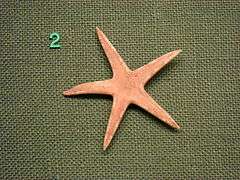Psilaster andromeda
Psilaster andromeda is a species of starfish in the family Astropectinidae. It is native to the northeastern Atlantic Ocean where it occurs at abyssal depths.
| Psilaster andromeda | |
|---|---|
 | |
| Scientific classification | |
| Kingdom: | |
| Phylum: | |
| Class: | |
| Order: | |
| Family: | |
| Genus: | |
| Species: | P. andromeda |
| Binomial name | |
| Psilaster andromeda J. Müller & Troschel, 1842[1] | |
| Synonyms | |
| |
| Wikimedia Commons has media related to Psilaster andromeda. |
Distribution and habitat
Psilaster andromeda is a deep water species of starfish native to the northeastern Atlantic Ocean. Its range extends from Murmansk and the coasts of Norway to the Faeroes, the Kattegat, the United Kingdom and the Bay of Biscay. It is present in the Rockall Trough.[2] It is found in Norwegian fiords on muddy bottoms at depths of 60 to 80 m (200 to 260 ft).[3] It is also found in the Porcupine Seabight and on the Porcupine Abyssal Plain in the Northeast Atlantic at much greater depths.[4]
Biology
Psilaster andromeda is a carnivore, detritivore and omnivore.[2] It mainly feeds on molluscs such as Abra. Nucula, Rissoa and Tellina, echinoderms, foraminifera, and sometimes crustaceans and annelids.[5]
The gonads of Psilaster andromeda are located at the base of the arms and each one opens through a single gonopore. Fewer than 300 small oocytes are produced by each gonad. Some of these are phagocytosed and others are supplied with yolks and grow in size before being spawned.[6]
A parasitic turbellarian Triloborhynchus psilastericola is often present in the coelom of the starfish and when the worm is approaching maturation, it moves into the pyloric caeca and at the same time loses all its cilia.[3]
References
- Mah, Christopher (2013). "Psilaster andromeda (Müller & Troschel, 1842)". WoRMS. World Register of Marine Species. Retrieved 2014-01-09.
- Mah, Christopher. "Psilaster andromeda andromeda (Müller & Troschel, 1842)". World Asteroidea database. Retrieved 2014-01-09.
- Jespersen, Å.; Lützen, J. (1972). "Triloborhynchus psilastericola n. sp., a parasitic turbellarian (Fam. Pterastericolidae) from the starfish Psilaster andromeda (Müller and Troschel)". Zeitschrift für Morphologie der Tiere. 71 (3): 290–298. doi:10.1007/BF00280168.
- Howell, Kerry L.; Billett, David S. M.; Tyler, Paul A. (2002). "Depth-related distribution and abundance of seastars (Echinodermata: Asteroidea) in the Porcupine Seabight and Porcupine Abyssal Plain, N.E. Atlantic". Deep-Sea Research Part I: Oceanographic Research Papers. 49 (10): 1901–1920. doi:10.1016/S0967-0637(02)00090-0.
- Jangoux, Michel; Lawrence, John M. (1982). Echinoderm nutrition. CRC Press. p. 123. ISBN 9789061910800.
- Tylera, P. A.; Pain, S. L. (1982). "The reproductive biology of Plutonaster bifrons, Dytaster insigns and Psilaster andromeda (Asteroidea: Astropectinidae) from the Rockall Trough". Journal of the Marine Biological Association of the United Kingdom. 62 (4): 869–887. doi:10.1017/S0025315400070405.